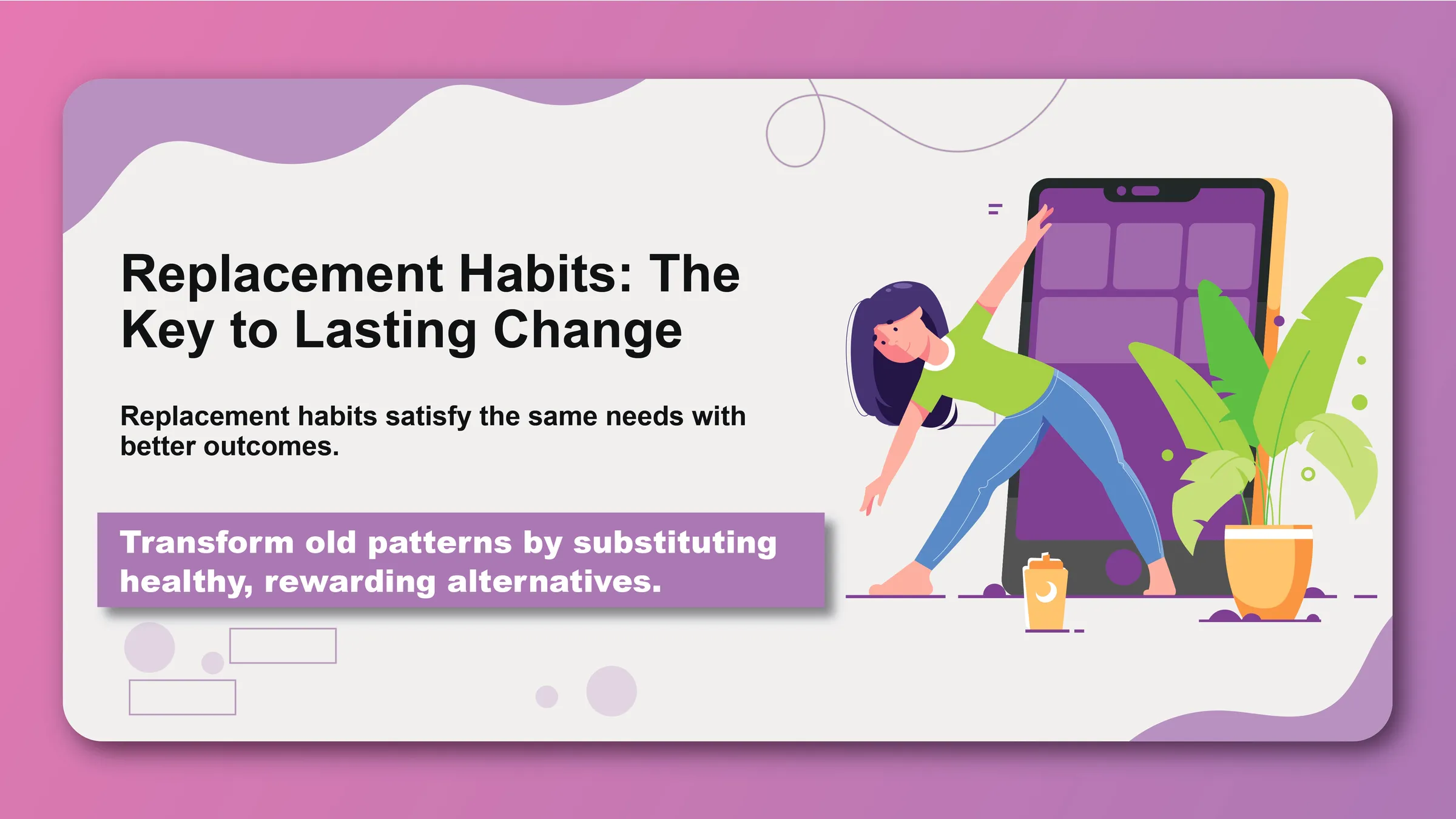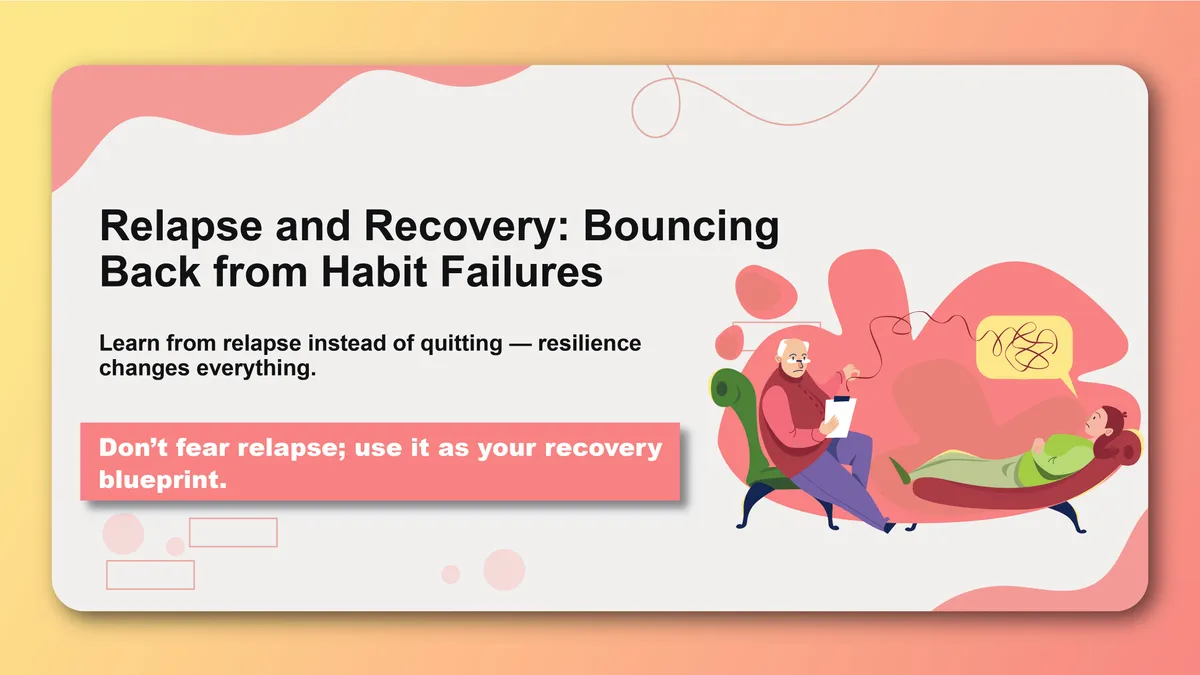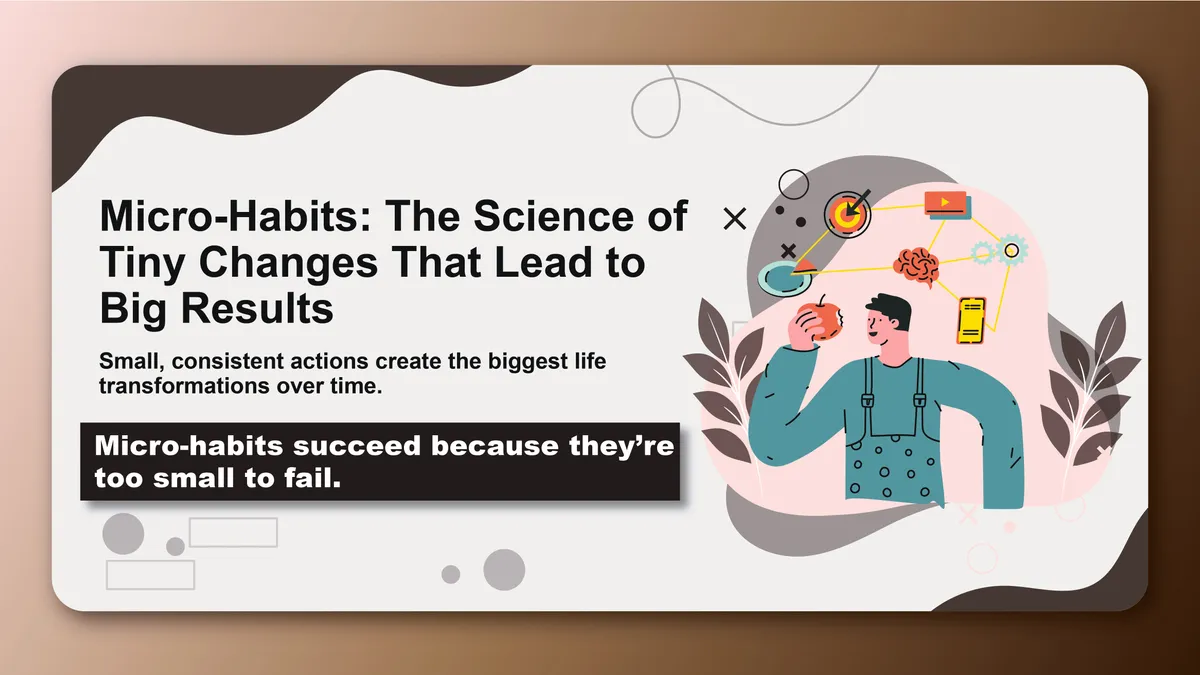When most people try to break a bad habit, they focus on stopping the unwanted behavior. However, research and practical experience consistently show that the most successful approach to breaking bad habits isn't elimination—it's replacement. The principle is simple but powerful: instead of trying to create a void where the bad habit used to be, fill that space with a positive alternative that serves the same underlying need.
Replacement habits work because they address a fundamental truth about human behavior: habits exist because they serve important functions in our lives. Whether it's managing stress, alleviating boredom, seeking comfort, or fulfilling social needs, every habit—even bad ones—provides some form of benefit or relief. Simply removing the habit without addressing these underlying needs creates a psychological vacuum that almost inevitably gets filled by the return of the old habit or the development of a new problematic behavior.
The replacement strategy acknowledges that you're not just trying to stop doing something; you're trying to change how you respond to specific triggers and fulfill particular needs. By consciously choosing better alternatives that provide similar benefits, you can maintain the positive functions of the habit while eliminating the negative consequences.
This approach is particularly effective because it works with your brain's natural tendencies rather than against them. Instead of relying solely on willpower to resist urges, you redirect those urges toward beneficial behaviors. The neural pathways that trigger the habit response remain active, but they become linked to positive actions instead of destructive ones.
This comprehensive guide will explore the psychology behind replacement habits, show you how to identify effective substitutes for your bad habits, and provide practical strategies for implementing replacement behaviors that create lasting change. Whether you're struggling with stress eating, excessive screen time, negative thinking patterns, or any other unwanted behavior, the replacement approach offers a sustainable path to transformation.
The Psychology of Replacement
Why Replacement Works Better Than Elimination
Natural Behavior Patterns Humans are naturally inclined to develop habits and routines. When you eliminate a habit without replacing it, your brain naturally seeks something else to fill that behavioral slot, often defaulting back to the original habit or developing a new problematic behavior.
Trigger-Response Pathways Bad habits are triggered by specific cues in your environment or emotional state. Simply trying to ignore these triggers requires constant mental energy and often fails during moments of stress or distraction. Replacement habits acknowledge these triggers but redirect the response toward positive behaviors.
Functional Equivalence Every habit serves a function—stress relief, entertainment, social connection, energy management, or emotional regulation. Replacement habits work because they provide the same functional benefits as the original habit, making the substitution feel natural and satisfying.
Reduced Resistance Your brain naturally resists elimination because it perceives the loss of a familiar behavior as a threat. Replacement reduces this resistance because you're not taking something away—you're upgrading to something better.
The Neuroscience of Habit Substitution
Neural Pathway Redirection When you consistently replace one behavior with another in response to the same trigger, you gradually strengthen new neural pathways while weakening old ones. The trigger remains the same, but the response changes.
Dopamine and Reward Satisfaction Effective replacement habits provide similar or superior dopamine rewards compared to the original habit. This neurochemical satisfaction is crucial for making the new behavior feel rewarding and sustainable.
Automaticity Transfer Over time, replacement habits can become as automatic as the original habits they replaced. The same neurological processes that made bad habits feel effortless can work in favor of positive behaviors.
Stress Response Management Replacement habits often work better under stress because they provide an alternative outlet for the same psychological needs that drive the original habit during challenging times.
Identifying Effective Replacement Habits
Understanding Habit Functions
Stress Management Many bad habits serve as stress relief mechanisms, providing temporary escape or comfort during difficult emotions.
Common Stress-Related Bad Habits:
- Stress eating or drinking
- Excessive social media scrolling
- Smoking or substance use
- Nail biting or other nervous behaviors
- Procrastination and avoidance behaviors
Effective Stress-Relief Replacements:
- Deep breathing exercises
- Brief physical exercise or stretching
- Mindfulness meditation
- Journaling or expressive writing
- Listening to calming music
Boredom and Entertainment Some habits develop as ways to fill time, seek stimulation, or avoid uncomfortable feelings of emptiness or restlessness.
Boredom-Related Bad Habits:
- Mindless snacking
- Excessive TV watching
- Compulsive shopping
- Social media browsing
- Gaming or other digital distractions
Engaging Boredom Replacements:
- Reading books or educational content
- Creative hobbies and activities
- Physical exercise or outdoor activities
- Learning new skills
- Social interaction and connection
Energy and Mood Regulation Many habits function as ways to manage energy levels, boost mood, or create feelings of control and accomplishment.
Energy-Related Bad Habits:
- Caffeine overconsumption
- Sugar crashes and energy seeking
- Afternoon slumping behaviors
- Sleep procrastination
- Mindless stimulation seeking
Energy-Boosting Replacements:
- Natural movement and exercise
- Healthy snacking with protein and complex carbs
- Brief outdoor exposure and fresh air
- Power napping or rest
- Hydration and proper nutrition
Replacement Criteria and Selection
Functional Match The most important criterion for a replacement habit is that it serves the same underlying function as the original habit.
Function Assessment Questions:
- What need does my bad habit fulfill?
- When do I most feel compelled to perform this habit?
- What emotions or situations trigger this behavior?
- What immediate benefits do I get from this habit?
- What would I lose if I stopped this behavior completely?
Accessibility and Convenience Replacement habits must be easily accessible when triggers occur. If the replacement is complicated or inconvenient, you'll likely default to the original habit during moments of low willpower or high stress.
Accessibility Factors:
- Can be performed in the same locations as the original habit
- Requires minimal preparation or special equipment
- Fits within the same time constraints
- Doesn't require significant schedule changes
- Available during all the situations where triggers occur
Satisfaction and Reward Effective replacements provide similar or superior satisfaction compared to the original habit. This doesn't mean they need to be as immediately gratifying, but they should provide meaningful benefits that you can recognize and appreciate.
Reward Evaluation:
- Immediate satisfaction or relief
- Sense of accomplishment or progress
- Physical or emotional benefits
- Alignment with values and goals
- Long-term positive consequences
Sustainability and Scalability Choose replacement habits that you can maintain long-term and that can evolve with your changing needs and circumstances.
Sustainability Considerations:
- Realistic for your current lifestyle and constraints
- Flexible enough to adapt to different situations
- Doesn't require perfect conditions to perform
- Provides ongoing benefits that motivate continuation
- Can be modified or upgraded over time
Implementation Strategies
The Gradual Substitution Method
Phase 1: Parallel Introduction Begin practicing the replacement habit alongside the existing bad habit, without initially trying to eliminate the original behavior.
Implementation Steps:
- Choose your replacement habit based on functional analysis
- Practice the new behavior in low-pressure situations
- Gradually introduce it in contexts where the bad habit typically occurs
- Build familiarity and comfort with the replacement
- Start noticing the benefits and rewards of the new behavior
Phase 2: Conscious Choice Create moments of conscious decision-making where you actively choose between the old habit and the replacement.
Choice Creation Strategies:
- Pause when you notice the trigger
- Remind yourself of both options
- Consider the immediate and long-term consequences
- Choose the replacement at least 50% of the time initially
- Celebrate successful replacements
Phase 3: Automatic Substitution Work toward making the replacement habit your automatic response to the original triggers.
Automation Techniques:
- Consistent practice in trigger situations
- Environmental modifications that support the replacement
- Mental rehearsal and visualization
- Identity shifting toward someone who performs the replacement
- Social support and accountability for the new behavior
The Complete Swap Method
Immediate Replacement For some habits and situations, it's more effective to completely stop the bad habit and immediately begin performing the replacement in all trigger situations.
When Complete Swap Works:
- The bad habit has clear, immediate negative consequences
- You have high motivation and commitment to change
- The replacement habit is well-established and familiar
- Environmental support is strong
- The functional match between habits is very close
Implementation Process:
- Choose a specific start date for the swap
- Prepare your environment to support the replacement
- Inform support people about your commitment
- Practice the replacement habit intensively before the swap date
- Implement the complete change and maintain consistency
Environmental and Social Support
Environmental Design Modify your environment to make replacement habits easier and more attractive while making original habits less accessible.
Environmental Modifications:
- Remove or hide triggers for the bad habit
- Place cues and tools for the replacement habit prominently
- Change physical layouts to support new behavioral flows
- Modify digital environments and app arrangements
- Create dedicated spaces for replacement activities
Social Integration Involve others in supporting your replacement habit strategy.
Social Support Strategies:
- Share your replacement goals with supportive friends and family
- Find accountability partners who can help monitor progress
- Join groups or communities focused on the replacement behavior
- Seek professional guidance when appropriate
- Create social situations that naturally support the replacement
Common Replacement Categories
Physical Health Replacements
Nutrition and Eating Replace unhealthy eating habits with nutritious alternatives that provide similar satisfaction.
Eating Replacement Examples:
- Replace stress snacking with herbal tea and fruit
- Substitute emotional eating with physical activity
- Swap mindless munching with mindful, planned snacks
- Replace fast food with prepared healthy alternatives
- Substitute sugary drinks with flavored water or kombucha
Movement and Exercise Use physical activity to replace sedentary or destructive habits.
Movement Replacements:
- Replace smoking breaks with walking breaks
- Substitute evening TV watching with gentle exercise
- Swap morning social media with stretching routines
- Replace afternoon energy drinks with brief workouts
- Substitute stress behaviors with physical tension release
Mental and Emotional Health Replacements
Stress and Anxiety Management Replace maladaptive coping mechanisms with healthy stress management techniques.
Stress Replacement Examples:
- Replace worry spirals with breathing exercises
- Substitute avoidance behaviors with gradual exposure
- Swap rumination with journaling or meditation
- Replace emotional numbing with mindful feeling processing
- Substitute perfectionist behaviors with self-compassion practices
Cognitive Patterns Replace negative thinking patterns with more balanced and constructive mental habits.
Cognitive Replacements:
- Replace catastrophic thinking with realistic assessment
- Substitute self-criticism with self-compassion
- Swap comparison with gratitude practice
- Replace victim mentality with empowerment focus
- Substitute helplessness with action planning
Productivity and Time Management Replacements
Procrastination Solutions Replace avoidance behaviors with engagement strategies that feel manageable and rewarding.
Procrastination Replacements:
- Replace task avoidance with tiny first steps
- Substitute perfectionism with "good enough" standards
- Swap overwhelming planning with simple action lists
- Replace distraction seeking with focused time blocks
- Substitute deadline panic with steady progress habits
Digital Wellness Replace problematic technology use with intentional digital habits and offline alternatives.
Digital Replacements:
- Replace mindless scrolling with purposeful reading
- Substitute notification checking with scheduled communication times
- Swap entertainment binging with creative activities
- Replace social media comparison with personal reflection
- Substitute digital multitasking with single-tasking focus
Overcoming Replacement Challenges
When Replacements Don't Feel Satisfying
Adjustment Period Expectations Understand that replacement habits may not feel as immediately satisfying as the original habits, especially in the beginning.
Satisfaction Building Strategies:
- Focus on long-term benefits and alignment with values
- Track and celebrate small wins and progress
- Enhance the replacement experience with pleasant additions
- Connect the replacement to bigger goals and meaning
- Be patient with the adjustment process
Reward Enhancement Actively work to make replacement habits more rewarding and enjoyable.
Enhancement Techniques:
- Add elements of fun, creativity, or social connection
- Connect replacements to music, nature, or other enjoyable stimuli
- Create rituals and ceremonies around replacement habits
- Combine replacements with other activities you enjoy
- Gradually upgrade and evolve replacement habits over time
Dealing with Trigger Intensity
High-Stress Situations During intense trigger situations, it can be challenging to remember or choose replacement habits.
Intensity Management:
- Prepare and practice replacement habits during calm periods
- Create simple, easy-to-remember replacement options
- Use environmental cues and reminders for stressful times
- Develop graduated replacement options for different intensity levels
- Build in support systems for high-trigger periods
Multiple Trigger Management When bad habits are triggered by various situations, develop a toolkit of replacement options.
Multi-Trigger Strategies:
- Identify different categories of triggers and contexts
- Develop specific replacements for each trigger type
- Practice flexibility in replacement selection
- Create quick decision-making tools for replacement choice
- Build overall resilience and coping capacity
Replacement habits represent one of the most effective approaches to lasting behavior change because they work with your natural psychological patterns rather than against them. By understanding the functions your bad habits serve and finding positive alternatives that meet those same needs, you can create sustainable change that feels natural and rewarding.
The key to successful replacement is taking time to truly understand why your bad habits exist and choosing alternatives that genuinely address those underlying needs. This isn't about willpower or forcing yourself to change—it's about creating better options that your brain naturally wants to choose.
Remember that replacement is a process that takes time and practice. Be patient with yourself as you experiment with different alternatives and refine your approach. The most successful replacements are those that evolve and improve over time, becoming increasingly satisfying and automatic.
Whether you're working on your first replacement habit or optimizing an existing strategy, the principles and techniques in this guide will help you create lasting positive change by building better alternatives rather than simply trying to eliminate unwanted behaviors.
Ready to transform your bad habits into positive alternatives? Start building effective replacement habits with Habityzer and discover how the right substitutions can create lasting change that feels natural and sustainable.



